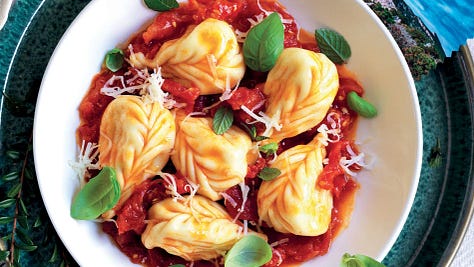Culurgiones: A Tale of Many Empires
Tracking a cherished -and delicious- Sardinian dish through history
Over the past 2 years, I have spent quite a bit of time coming and going from Sardinia. From the imposing presence of the northern boulders to the sprawling white sand beaches in the southeast, it’s an island of harmony.
It’s worth mentioning that Sardinia is not Italy. Well, technically I suppose it is but try telling a Sardinian that— I dare you. In my experience, if you ask a Sardinian where they’re from they will say Sardinia first, and Italy second. Despite the unification into Italy in 1861, Sardinia has had quite a storied and unique past. From the Carthaginians and Phoenicians to the Moors and Spanish, this Mediterranean island has witnessed its fair share of empires, and their influence is evident in the cuisine. Foods like Fregula (a tiny round semolina pasta), seadas (a fried semolina pastry filled with pecorino and lemon zest and drizzled in honey), and my favorite— Culurgiones.



(from left to right: fregula, seadas, culurgiones)
Culurgiones are essentially a stuffed pasta. Closely resembling a dumpling, they are filled with mashed potato, pecorino, and mint. They are lovingly sealed and pinched closed to create an intricate and iconic design— one that is on my mind 24/7.
If you try to order Culurgiones in Tuscany, they’ll look at you like you’ve grown 2 heads. It’s a Sardinian dish. Born on an island where Greeks, Phoenicians, Romans, Spaniards, and Moors have all anchored their ships to engage in trade and war, it’s easy to see how their influence would be felt in the island’s cuisine.
In Sardinia, sheep have been grazing here for millennia, dating back to the North African civilizations that arrived as early as 2000 BC. It’s why pecorino and ricotta are so famous here. Potatoes arrived thanks to the Spanish friars in the late 16th-early 17th century, when the island was run by the Spanish kingdom of Aragon. Mint (Mentha requienii) is native to the island and has been here long before recorded history.
In essence, Culurgiones represent something larger than a plate on a dinner table. They are deeply rooted in Sardinian tradition and craftsmanship and represent a fingerprint of each civilization who landed here as well as the soul of the island itself—a true metaphor for the island.
I’m grateful to be living here and to experience this unique blend of cultures, especially when the end result is as delicious as a plate of Culurgiones.
If you haven’t already found this YouTube channel (^^), I encourage you to smash the subscribe button immediately.
More soon,
Kenza ✨






